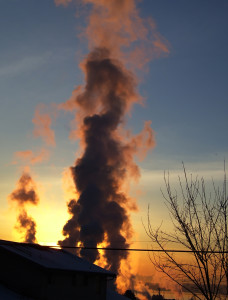 The EPA’s Rules for New Residential Wood Stoves: A Sell-Out to the Wood Stove Industry?
The EPA’s Rules for New Residential Wood Stoves: A Sell-Out to the Wood Stove Industry?
On February 4, the EPA issued its long-awaited final rules for the manufacture and sale of new residential wood stoves. We weren’t fans of the proposed rule, and we think the final rule is even worse. After intense lobbying, the EPA caved to industry pressure, and the result is a rule that may do more harm than good to air quality.
Cordwood Testing: Up in Smoke
One of the biggest problems with the existing EPA wood stove certification process is that it uses kiln-dried lumber arranged in a crib formation. Since people don’t operate their wood stoves like this in the real world, the proposed EPA rule sought to address this by specifying the use of cordwood in the testing process.
Unfortunately, lobbying from the wood stove industry spurred the EPA to back away from this common sense step forward and to revert to testing with kiln-dried cribwood, not cordwood, for stove certification. This makes it impossible to extend the in-lab findings to the real world. Even in laboratory tests in controlled conditions, emissions from burning cordwood are higher than from burning cribwood (see studies here, here, and here), so in-home emissions will certainly be higher than projected.
Lower Wood Stove Emissions—But For How Long?
The EPA’s decision to lower allowed emissions from wood stoves in the new rules was applauded by health and environmental groups as a way to lower particulate matter (PM) emissions. But a closer look shows that this limit may have no effect—or even the opposite effect—on emissions in the longer term.
To meet these lowered emission limits, wood stove manufacturers are likely to use catalytic wood stove technology. Unfortunately, these catalytic components can break down in as little as two years. And when the components begin to wear out, the PM emissions increase dramatically. Stove maintenance is entirely voluntary; the proposed rule does not address the issues of degradation or proper maintenance of catalytic components.
Clearly there’s no economic incentive for the user of the stove to replace the catalytic components. There is also no functional reason for them to replace the catalytic components: the negative consequences of degraded catalytic components, which are primarily increased emissions, occur mostly outside the end user’s home. Thus, there is no reason to think that owners will replace the degraded catalytic components or expend the effort to maintain them properly.
The EPA states that the lifespan of a wood heater is over 20 years. Therefore, after a few years of use, wood smoke emissions from catalytic wood stoves will potentially be as high as those from an uncertified conventional wood heater. Thus, the unintended consequence of the EPA’s lower emissions limit is likely to be higher emissions.
The Long Phase-Out Period
After lobbying from the wood stove industry, the EPA settled on a generous (to industry) 5-year phase-out period for manufacturers to transition to the new standards and sell off their existing models.
The industry is already leveraging this extended transition as a way to gin up sales of wood stoves by making consumers feel like they must act now before the new EPA rules take effect (and prices increase). One ad for an outdoor wood boiler urges consumers to act now, claiming that they will only be available for a limited time:
VOCs and Air Toxics
In their summary of the final rules, the EPA claims that the lower emission limits will reduce VOC pollution. Unfortunately, as far as we’re aware, there is no scientific basis for this claim.
The new rules do not test for, or necessarily reduce, VOCs or air toxics (including formaldehyde, benzene, dioxins, and polycyclic organic matter). Importantly, studies show that these are not reduced in parallel with PM emissions (see here, here, and here). One technical report prepared for the EPA concluded, “The data demonstrate that particulate emissions cannot be used as a surrogate measurement for POM [polycyclic organic matter] emissions of woodstoves.”
The EPA’s mission is to protect human health, and this rule was originally intended to reduce wood smoke pollution to decrease the harmful effects of wood smoke. Unfortunately, we have several reasons to fear that these measures may make things even worse.





